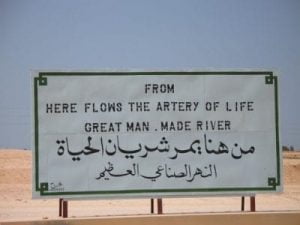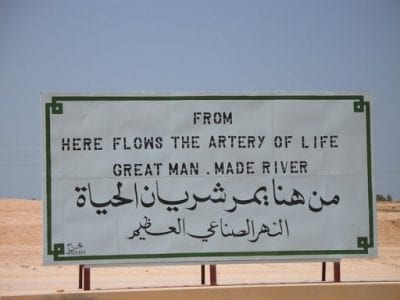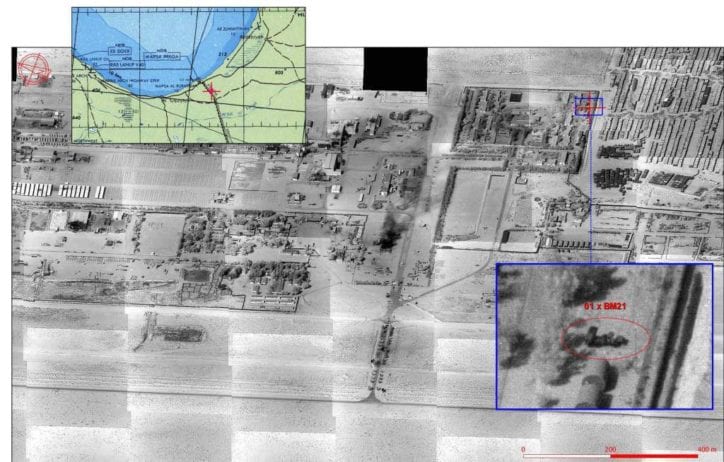It is a war crime to attack essential civilian infrastructure. 95% of Libya is desert and 70% of Libyans depend on water which is piped in from the Nubian Sandstone Aquifer System under the southern desert. The water pipe infrastructure is probably the most essential civilian infrastructure in Libya. Key to its continued function, particularly in time of war, is the Brega pipe factory which enables leaks and breaks in the system to be repaired.
NATO has admitted that its jets attacked the pipe factory on 22 July, claiming in justification that it was used as a military storage facility and rockets were launched from there.
The Great Man-Made River
Libyans like to call the Great Man-Made River “The eighth wonder of the world”.
Colonel Gaddafi, a man of many visions, had dreamed of seeing an abundance of fresh water in Libya, and wanted to make his home country stand as a proud and free nation. In 1953, the quest for black gold in the vast deserts that reside in the southern part of Libya, led to the discovery of oil and fossil water. The quadruple aged water aquifers that were uncovered in the 50s had projected sizes varying from 4,500 to 20,000 cubic kilometers. The majority of this water supply was accumulated almost 15,000 to 25,000 years ago, while some water tanks are believed to be a few thousand-years-old.
 After a hardcore battle between Gaddafi and Muhammad Idris bin Muhammad al-Mahdi as-Senussi, King of Libya, Gaddafi and his army acquired power in a coup against Muhammad Idris in 1969. The new government, also called the Libyan Arab Jamahiriya, made the oil companies state owned and invested a great deal of the oil profits to funnel the flow of drinking water from the underground aquifers, by installing a large number of bore wells throughout the Libyan land. Big farms were created in a southern region of Libya to motivate men and women to relocate to the desert and farm in those places. However, a lot of people in Libya preferred living in the northern and coastal parts of the country, for there was a steady and ample supply of water there.
After a hardcore battle between Gaddafi and Muhammad Idris bin Muhammad al-Mahdi as-Senussi, King of Libya, Gaddafi and his army acquired power in a coup against Muhammad Idris in 1969. The new government, also called the Libyan Arab Jamahiriya, made the oil companies state owned and invested a great deal of the oil profits to funnel the flow of drinking water from the underground aquifers, by installing a large number of bore wells throughout the Libyan land. Big farms were created in a southern region of Libya to motivate men and women to relocate to the desert and farm in those places. However, a lot of people in Libya preferred living in the northern and coastal parts of the country, for there was a steady and ample supply of water there.
According to a March 2006 report by the BBC the industrialisation of Libya following the Great Al-Fatah Revolution in 1969, put strain on water supplies and coastal aquifers became contaminated with sea water, to such an extent that the water in Benghazi was undrinkable. Finding a supply of fresh, clean water became a government priority and fortunately oil exploration in the 1950s had revealed vast aquifers beneath Libya’s southern desert.
 Gaddafi’s government created a new plan: bring the water to the people. The Jamahiriya administration carried out the preliminary feasibility reports in 1974. In 1983, the wheels for the Great Man-Made River project were set to roll. The Great Man-Made River Project, a Jamahiriya government financed venture, was going to be developed in five stages. All five stages were a completely different project by themselves, however, when combined, the stages would form an integrated set-up.
Gaddafi’s government created a new plan: bring the water to the people. The Jamahiriya administration carried out the preliminary feasibility reports in 1974. In 1983, the wheels for the Great Man-Made River project were set to roll. The Great Man-Made River Project, a Jamahiriya government financed venture, was going to be developed in five stages. All five stages were a completely different project by themselves, however, when combined, the stages would form an integrated set-up.
As water in the newly formed Libya was considered to be a human right for its people, Gaddafi had to make this happen for the happiness of his people.
In August 1984, Muammar Al Qadhafi laid the foundation stone for the pipe production plant at Brega. The Great Man-Made River Project had begun. Adam Kuwairi, a senior figure in the Great Man-Made River Authority (GMRA), vividly remembers the impact the fresh water had on him and his family:
“The water changed lives. For the first time in our history, there was water in the tap for washing, shaving and showering. The quality of life is better now, and it’s impacting on the whole country.”
The first phase was officially launched at the end of 1991, supplying more than a million cubic meters of fresh water every day from a pipeline that stretches more than 1000 km, from Sirte to Benghazi. The second phase supplies one million cubic meters of underground water each day to the coastal belt of the country, as well as supplying water to Tripoli. And finally, the third phase offers the organized development of the first phase set-up, and provides Tobruk and other cities close to the coastline with a new underground water supply.
The network of concrete pipes, which each have a diameter of 4 meters each, stretch more than 3500 kilometers. These pipes are hidden beneath the wilderness of the desert to stop vaporization of the water. There are more than 1000 wells, countless sections of concrete pipes, and 250 million cubic meters of excavation.
On 3 April 2011 Libya warned that NATO-led air strikes could cause a “human and environmental disaster” if air strikes damaged the Great Man-Made River project.
Engineer and project manager Abdelmajid Gahoud told foreign journalists in Tripoli:
“If part of the infrastructure is damaged, the whole thing is affected and the massive escape of water could cause a catastrophe,” leaving 4.5 million thirsty Libyans deprived of drinking water.
The final two stages of the man-made river required stretching the supply system collectively – which, once achieved, would irrigate more than 100,000 hectares of terrain. Or, as Gaddafi described, the venture would make the country as green as the flag of the Libyan Arab Jamahiriya.
The Great Man-Made River gained international recognition, which led to the United Nations Educational, Scientific and Cultural Organization’s acceptance of Libya’s offer to fund the Great Man-Made River International Water Prize, a merit that benefits phenomenal scientific studies on water consumption in waterless locations. Also, because of its international recognition, many people from other nations were employed in Libya, especially in the Great Man-Made River Project, for many years.
The Brega Pipe-Making Plant
 The Pre-Stressed Concrete Cylinder Pipe Factory at Brega is one of only two such facilities in Libya – the other being at Sarir to the east. This makes it a very important component of the Great Man-Made River – with two production lines making up to 80 pipes a day.
The Pre-Stressed Concrete Cylinder Pipe Factory at Brega is one of only two such facilities in Libya – the other being at Sarir to the east. This makes it a very important component of the Great Man-Made River – with two production lines making up to 80 pipes a day.
According to the BBC:
The engineer in charge of the Brega pipe factory is Ali Ibrahim. He is proud that Libyans are now running the factory:
“At first, we had to rely on foreign-owned companies to do the work. But now it’s government policy to involve Libyans in the project. Libyans are gaining experience and know-how, and now more than 70% of the manufacturing is done by Libyans. With time, we hope we can decrease the foreign percentage from 30% to 10%.”
As a result, Libya is now a world leader in hydrological engineering and it wants to export its expertise to other African and Middle-Eastern countries facing similar problems with their water.
According to the official web site of the Great Man-Made River Authority:
Approximately 500,000 pre-stressed concrete cylinder pipes have been manufactured to date. Approximately 500,000 pipes transported to date. Pipe transportation is continuous process and the work goes on day and night, distance traveled by the transporters is equivalent to the sun and back. Over 3,700 km of haul roads was constructed alongside the pipe line trench to enable the heavy truck – trailers to deliver pipe to the installation site.
NATO Attack
in July 2011, The North Atlantic Treaty Organization (NATO) not only bombed the Great Man-Made River water system and pipelines near Brega, but additionally eradicated the plant that created the concrete pipes that were used as replacements during repairs. On 22 July NATO warplanes attacked the pipe making plant at Brega killing six of the facility’s security guards:
RAF jets hit 6 ammunition storage facilities near Zlitan & a building being used as a base for rocket launchers threatening Misratah. #Libya
— Air Cdre Ian Wood (@UKMilOps) July 23, 2011
As you can see from Google Earth the 100s of pipes at this facility, out in the desert south of Brega, make it clear, even from the air, that this was a pipe-production plant:
Video footage shows a major building within the plant had been destroyed and there was also damage to at least one of the trucks which was used to transport pipes to places where repairs are required:
According to AP, Abdel-Hakim el-Shwehdy, head of the company running the project, said:
“Major parts of the plant have been damaged. There could be major setback for the future projects.”
Following the start of NATO’s ‘humanitarian’ bombardment of Libya, the summers of 2011 became a cause for a large number of foreign employees to leave the country. NATO justified their actions by claiming that the pipeline factory was used as a warehouse for the military. Additionally, they also said that the same pipeline manufacture plant was used as a launch site for missiles and rockets.
When NATO forces bombed that pipe building plant, the water supply system that supplied the general public with water for personal consumption and agricultural purposes – hitting Libya’s essential infrastructure. The development of the final two stages of the river project were set to be finished within the next 20 years, but thanks to NATO’s ‘humanitarian’ war on Libya, the projects’ future faced great peril.
Water supply to Brega Cut
On Monday 18 July rebel spokesman Shamsiddin Abdulmolah told AFP that remnants of Gadhafi’s troops were holed up among industrial facilities in Brega with supplies dwindling.
“Their food and water supplies are cut and they now will not be able to sleep.”
Given the rebel boasts that the pro-Gadaffi forces in Brega had no water, the question has to be posed whether this attack was a deliberate attempt to prevent repair of the pipeline into Brega.
NATO Response
In response to HRI enquiry, NATO press office said:
We can confirm that we targeted Brega on July 22nd and we stroke successfully: one military storage facility and four armed vehicles.”
HRI requested clarification:
The building you hit (apparently in the Brega pipe factory) was being used for what kind of military storage?
What considerations were taken into account to ensure that the strikes did not damage civilian infrastructure or was damage to the civilian infrastructure considered legitimate?
Given the potential consequences to civilians of damage to the pipe factory and the ability of the engineers to be able to repair broken water pipelines I hope you will appreciate the importance of these questions.
On the 26th July 2011, at the NATO press conference in Naples, Colonel Rolond Lavoie, neglecting to inform the assembled journalists that the “concrete factory” plays an important role in preserving Libya’s water supply, said:
Now in the area of Brega, NATO strikes included armoured vehicles, rocket launchers, military storage facilities and a repurposed concrete factory from which Pro-Gaddafi forces were using multi-viral [sic] rocket launchers, exposing the population to indirect fire.
Let me show you some intelligence pictures that illustrate what we have observed at this concrete factory. By the way these pictures will be made available on the NATO site so it will be possible for the media can download them.
So basically repeatedly over the last few weeks we got clear intelligence indicating that pro-Gadaffi forces are using this factory for military purposes. This factory is being used to hide military material including Multiple Rocket Launchers. These weapons have been used every day from within this factory compound and then carefully hidden after the day within or along massive pipes you can see in this picture.
Slide 1 20 July apparently shows a BM-21 rocket launcher -a model of rocket launcher widely used by both loyalist and rebel forces in Libya.
Slide 2 23 July apparently shows a BM-21 rocket launcher. The slide shows black smoke in the centre of the picture which suggests two hits (possibly on vehicles) have already been made, with the BM-21 left intact.
Neither slide appears to show the building which was destroyed in the video or helps to understand when or why that was hit. So the photos lead to more questions than they answer – clearly the BM-21, spotted on the 20th, was not considered a priority target, and there is nothing in the NATO explanation which explains why the water supplies of the Libyan people have now been put at such risk.
On 27th July further enquiries by HRI elicited the additional information that
The factory is being used to hide military material, including multiple rocket launchers. These weapons have been used every day from within this factory compound and then carefully hidden after the day within the factory buildings and the area.
and
All sites that could be used by the pro-Qadhafi regime forces to threaten or attack civilians can be considered as a legitimate target by NATO in full accordance with UNSCR 1973. That resolution mandates the use of all necessary measures to protect civilians in Libya from attack or threat of attacks.
According to the NATO press office, the attack was within the rules of engagement agreed upon by all 28 countries in the coalition by consensus. It seems unlikely that the rules of engagement would allow this attack or that the states in the Security Council would agree that a devious interpretation of UN Security Council Resolution 1973 should supercede international humanitarian law.
NATO have failed to provide answers to the following questions:
- Do you have any concrete evidence that rockets were fired from inside the pipe-making plant?
- Can you explain the precise targeting and timing of strikes within this facility?
- What steps were taken to ensure collateral damage to the facility was avoided?
- What alternatives were considered to military strikes on this factory?
Applicable humanitarian law
The Laws of War were designed to prevent attacks on targets indispensible to the civilian population, so attacking a civilian infrastructure target such as this plant is a war crime.
Even if rockets were being fired from within the location (for which no evidence has been produced) or this facility was being used for military storage by Gadaffi forces, or housed armoured vehicles, attacking the pipe-making factory in a way that leaves it severely damaged is illegal as this facility is important to the water supplies of Libyan civilians.
The citing of UNSCR 1973 does not supercede the need for NATO forces to obey the laws of war.
Applicable humanitarian law includes (inter alia):
Rule 15. In the conduct of military operations, constant care must be taken to spare the civilian population, civilians and civilian objects. All feasible precautions must be taken to avoid, and in any event to minimize, incidental loss of civilian life, injury to civilians and damage to civilian objects. [IAC/NIAC]
Rule 16. Each party to the conflict must do everything feasible to verify that targets are military objectives. [IAC/NIAC]
Rule 17. Each party to the conflict must take all feasible precautions in the choice of means and methods of warfare with a view to avoiding, and in any event to minimizing, incidental loss of civilian life, injury to civilians and damage to civilian objects. [IAC/NIAC]
Rule 18. Each party to the conflict must do everything feasible to assess whether the attack may be expected to cause incidental loss of civilian life, injury to civilians, damage to civilian objects, or a combination thereof, which would be excessive in relation to the concrete and direct military advantage anticipated. [IAC/NIAC]
Rule 54. Attacking, destroying, removing or rendering useless objects indispensable to the survival of the civilian population is prohibited.
Human Rights Investigations demands:
- The immediate cessation of the bombing campaign by NATO which is putting Libyan civilians in mortal danger
- A peace congress be convened to bring this conflict to a rapid end.
The Fight For Water
 Clean, sparkling water – much like the water made available to the Libyans by the Great Man-Made River – is not only a vital source for humans, but all living things. With no drinkable water, we just cannot perform.
Clean, sparkling water – much like the water made available to the Libyans by the Great Man-Made River – is not only a vital source for humans, but all living things. With no drinkable water, we just cannot perform.
At the moment, more than 39% of the human population has very little or no access to safe, healthy and clean water – a number which is likely to leap up to 50% within just a few years. And as per the United Nations Development Program, worldwide intake of water is increasing every 20 years. While at the same time, after every 365 days, the majority of the great deserts in the world are growing wider, and the volume of functional farming terrain is shrinking in size.
However, there is more to the NATO ‘humanitarian’ bombardments of the Great Man-Made River Projects. In 2007, the United Nations Environment Program mentioned the water for revenue program, which earnestly encourages water to be a privately owned business. And, on the other hand, the World Bank implemented a strategy for privatizing water.
“The wars of the twenty-first century will be fought over water,”
…says Ismail Serageldin, the founding director of Bibliotheca Alexandrina and a former director of the World Bank.
In application, this means that both the World Bank and the United Nations want to fasten the water sources, allowing them to be used as a means of power. And once they entirely regulate these means, those means become financial assets, only to be sold back to the ‘free’ countries with a price tag. And, naturally, the prices for the freely available product will increase as the demand increases and water supplies are reduced.
However, what happened to the Great Man-Made River in the summers of 2011 can be best explained by the dialectical method (understanding the ‘problem,’ its ‘reaction’ and a ‘solution’).
In Libya’s case, the bombardment on the water supply system created a ‘problem’. Subsequently, a ‘reaction’ in the form of an instantaneous prevailing need, was triggered. More than 60% of the country’s people depended on the Great Man-Made River water supply for personal and commercial use. However, a few days after the demolition of the Great Man-Made River, over 50% of Libya had no running water. Finally, an established ‘solution’ was enforced – make the people of the war-torn nation reliant on a single water source – and consequently bound the people to their new ‘democratic’ government.
Sources:






